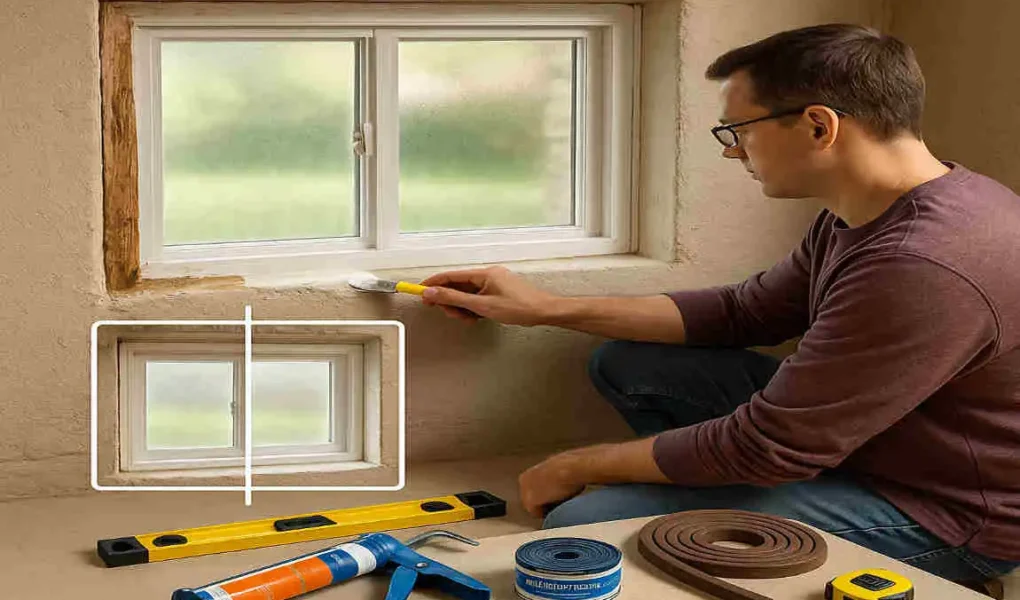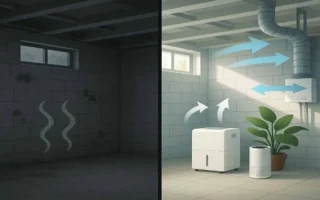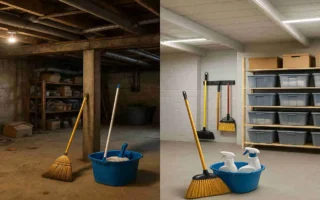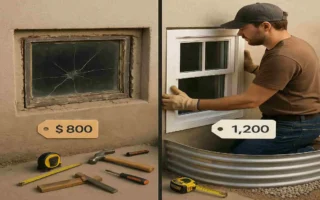Basement windows are often overlooked in home maintenance, but they play a crucial role in keeping your house safe and dry. These windows provide natural light, ventilation, and an emergency exit in the event of an emergency. However, if not properly maintained, basement windows can lead to a host of problems, from water leaks to mould growth.
Understanding Basement Windows
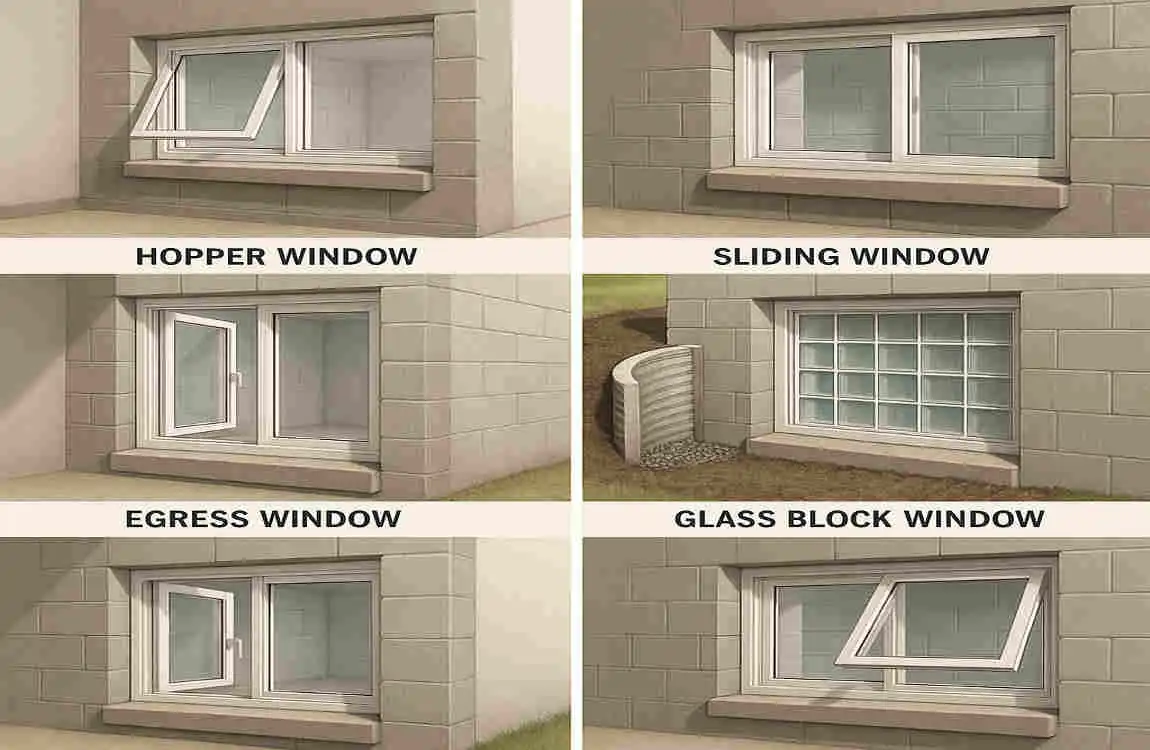
Types of Basement Windows
Basement windows come in various shapes and sizes, each designed to fit specific needs and architectural styles. Some common types of basement windows include:
- Hopper windows: These windows open inward from the top, allowing for easy cleaning and ventilation.
- Sliding windows: As the name suggests, these windows slide horizontally, making them ideal for tight spaces.
- Casement windows: These windows are hinged on one side and open outward, providing excellent ventilation and a clear view.
- Awning windows: Similar to casement windows, awning windows are hinged at the top and open outward, creating a protective awning over the window.
Common Problems with Basement Windows
Despite their importance, basement windows are prone to several common issues that can compromise the safety and dryness of your home. Some of these problems include:
- Leaks: Water can seep through cracks or gaps in the window frame, leading to moisture problems and potential damage.
- Cracks: Over time, the window frame or glass may develop cracks due to temperature fluctuations or physical impact.
- Condensation: Poor ventilation and high humidity levels can cause condensation to form on windows, leading to the growth of mould and mildew.
- Drafts: Gaps or cracks in the window can allow cold air to enter your basement, making it harder to maintain a comfortable temperature.
Impact on Basement and Home Safety
The problems mentioned above can have a significant impact on your basement and overall home safety. Here’s how:
- Moisture and mould: Water leaks and condensation can lead to moisture buildup in your basement, creating an ideal environment for mould and mildew growth. This not only affects the air quality but can also cause structural damage over time.
- Structural integrity: Cracks in the window frame or surrounding walls can compromise the structural integrity of your home, potentially leading to more severe issues in the future.
- Energy efficiency: Drafts and poor insulation around the window can cause your heating and cooling system to work harder, leading to higher energy bills and reduced efficiency.
By understanding the types of basement windows, common problems associated with them, and their impact on your home, you’ll be better equipped to tackle any repair projects that may arise.
Signs You Need to Fix Your Basement Window
Water Leaks and Moisture
One of the most obvious signs that your basement window needs attention is the presence of water leaks or moisture around the window. If you notice water stains, puddles, or a damp smell near your basement window, it’s time to take action.
Water leaks can occur due to various reasons, such as cracks in the window frame, gaps around the window, or poor drainage outside. Ignoring these leaks can lead to more severe issues, like mould growth and structural damage.
Visible Cracks or Damage
Another telltale sign that your basement window needs fixing is the presence of visible cracks or damage in the window frame or panes. These cracks can be caused by temperature fluctuations, physical impact, or age-related wear and tear.
Even small cracks can allow water to seep into your basement, so it’s essential to address them as soon as possible. In some cases, you may be able to repair the cracks yourself, while in others, you may need to replace the entire window.
Drafts and Temperature Fluctuations
If you notice drafts or temperature fluctuations in your basement, it could be a sign that your basement window is not properly sealed. Gaps around the window can allow cold air to enter during winter and hot air to enter during summer, making it harder to maintain a comfortable temperature.
Not only can this lead to higher energy bills, but it can also create an uncomfortable living space. By fixing your basement window and ensuring a tight seal, you can improve your home’s energy efficiency and comfort.
Mould or Mildew Growth
Mould and mildew thrive in damp, dark environments, making your basement an ideal breeding ground. If you notice mould or mildew growth near your basement window, it’s a clear indication that a moisture problem exists that needs to be addressed.
Mould and mildew can not only cause health issues but can also lead to structural damage if left unchecked. By fixing your basement window and improving ventilation, you can help prevent mould and mildew growth, keeping your basement healthy and dry.
Difficulty in Opening or Closing
If you’re having trouble opening or closing your basement window, it could be a sign that the window frame is damaged or that there’s a buildup of dirt and debris. This can not only be frustrating but also compromise your home’s safety in the event of an emergency.
By fixing your basement window and ensuring smooth operation, you can improve your home’s security and make it easier to enjoy fresh air and natural light in your basement.
By being aware of these signs, you can take proactive steps to fix your basement window and keep your home safe and dry.
Tools and Materials Needed for Fixing Basement Windows
Essential Tools
To successfully fix your basement window, you’ll need a few essential tools in your arsenal. Here’s a list of the most important ones:
- Screwdriver: A flathead or Phillips screwdriver will be useful for removing screws and accessing the window frame.
- Caulk gun: This tool is essential for applying caulk to seal gaps and cracks around the window.
- Putty knife: A putty knife will help you remove old caulk, paint, or debris from the window frame.
- Utility knife: A sharp utility knife can be used to cut away damaged weatherstripping or to trim excess caulk.
- Tape measure: Accurate measurements are crucial when replacing glass or ordering new window components.
- Safety glasses and gloves: Always prioritise your safety by wearing protective gear when performing repairs.
Materials
In addition to the right tools, you’ll also need a few key materials to effectively fix your basement window. Here’s what you should have on hand:
- Replacement glass: If your window pane is cracked or broken, you’ll need to replace it with a new piece of glass.
- Caulk: Choose a high-quality, weatherproof caulk to seal gaps and cracks around the window frame.
- Weather stripping: This material helps create a tight seal around the window, preventing drafts and moisture from entering.
- Sealant: A sealant can be used to protect the window frame from water damage and extend its lifespan.
- Paint: If you’re repairing the window frame, you may need to apply a fresh coat of paint to protect it from the elements.
Safety Gear
When working on any home repair project, it’s essential to prioritise your safety. Here’s the safety gear you should wear when fixing your basement window:
- Safety glasses: Protect your eyes from flying debris, glass shards, or chemicals.
- Gloves: Wear gloves to protect your hands from sharp edges, chemicals, or rough surfaces.
- Dust mask: If you’re sanding or removing old paint, a dust mask can help you avoid inhaling harmful particles.
By having the right tools, materials, and safety gear on hand, you’ll be well-prepared to tackle your basement window repair project with confidence.
Step-by-Step Guide: How to Fix a Basement Window
Inspecting the Window Thoroughly
Before starting any repairs, it’s crucial to thoroughly inspect your basement window. This will help you identify the root cause of the problem and determine the best course of action.
Start by examining the window frame, glass, and surrounding areas for any signs of damage, such as cracks, gaps, or water stains. Check the window’s operation to ensure it opens and closes smoothly. If you notice any issues, make a note of them so you can address them during the repair process.
Removing Damaged Parts Carefully
Once you’ve identified the damaged parts of your basement window, it’s time to carefully remove them. Start by removing any screws or fasteners that hold the window in place. Use a putty knife or utility knife to gently pry away any old caulk or weatherstripping.
If you need to remove the window pane, be sure to wear gloves and safety glasses to protect yourself from sharp edges or glass shards. Carefully remove the pane and set it aside for disposal or replacement.
Replacing Broken Glass or Panes
If your basement window has a cracked or broken pane, you’ll need to replace it with a new piece of glass. Start by measuring the dimensions of the old pane to ensure you get the right size replacement.
Once you have the new glass, apply a bead of caulk around the edges of the window frame. Carefully place the new pane into the frame, pressing it firmly into the caulk. Use glazing points or putty to secure the glass in place, following the manufacturer’s instructions.
Sealing Gaps and Cracks with Caulk or Weather stripping
To prevent water leaks and drafts, it’s essential to seal any gaps or cracks around your basement window. Start by cleaning the area around the window frame to ensure a good bond with the caulk or weather stripping.
Apply a bead of caulk to any gaps or cracks, using a caulk gun for precision. Smooth the caulk with a damp finger or putty knife to create a tight seal. For larger gaps, you may need to use weather stripping to create a more substantial barrier against moisture and air.
Repairing or Replacing Window Frames
If your basement window frame is damaged, you may need to repair or replace it entirely. Start by assessing the extent of the damage and determining whether a repair is feasible.
If the damage is minor, you can sand down the affected area and apply a new coat of paint or sealant. For more severe damage, you may need to replace the entire frame. Follow the manufacturer’s instructions for installing a new window frame, ensuring a tight fit and proper sealing to prevent air leaks.
Painting and Finishing Touches
Once you’ve completed the repairs, it’s time to add the finishing touches to your basement window. Start by sanding down any rough edges or surfaces to create a smooth finish.
Apply a coat of primer to the window frame, followed by a coat of high-quality exterior paint. Choose a colour that complements your home’s exterior and helps protect the window from the elements. Allow the paint to dry completely before closing the window or exposing it to moisture.
By following these step-by-step instructions, you can successfully fix your basement window and keep your home safe and dry.
Preventive Tips to Keep Basement Windows Safe and Dry
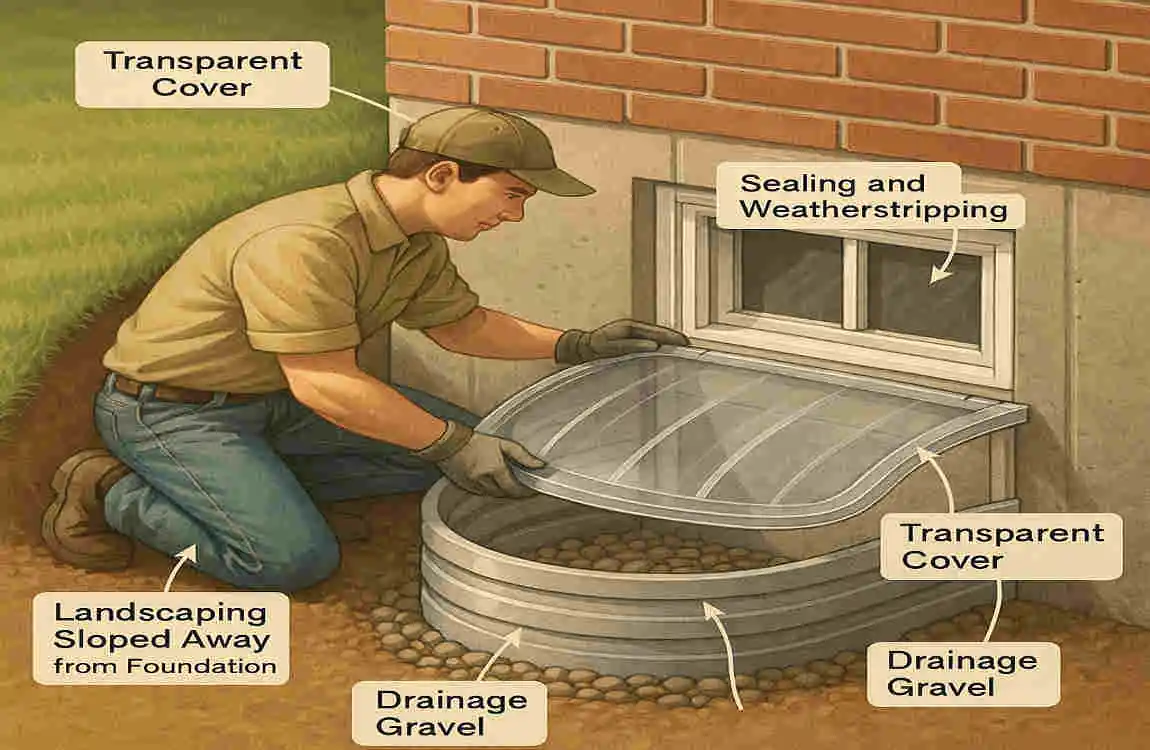
Regular Inspection and Maintenance Schedule
One of the best ways to keep your basement windows in top condition is to establish a regular inspection and maintenance schedule. By checking your windows at least once a year, you can catch any issues early and prevent more severe problems from developing.
During your inspection, look for signs of water leaks, cracks, or damage to the window frame or glass. Check the window’s operation to ensure it opens and closes smoothly. If you notice any issues, address them promptly to prevent further damage.
Importance of Proper Window Drainage and Exterior Window Wells
Proper window drainage and exterior window wells are crucial for keeping your basement windows safe and dry. Ensure that the ground around your window slopes away from your home to prevent water from pooling near the window.
If you have a window well, ensure it’s free of debris and that the drainage system is functioning properly. Consider installing a window well cover to protect the window from harsh weather and prevent leaves or other materials from clogging the drainage system.
Using Window Covers or Storm Windows During Harsh Weather
During harsh weather, such as heavy rain or snow, consider using window covers or storm windows to protect your basement windows. These additional layers can help prevent water from seeping into your basement and reduce the risk of damage to the window itself.
Window covers can be easily installed and removed as needed, while storm windows provide an extra layer of protection against the elements. Choose a high-quality, weather-resistant option that fits your window securely.
Tips for Controlling Basement Humidity and Ventilation
Controlling basement humidity and ventilation is crucial for maintaining the safety and dryness of your basement windows. High humidity levels can lead to condensation on windows, creating an ideal environment for mould and mildew growth.
To control humidity, consider using a dehumidifier in your basement, especially during humid months. Ensure proper ventilation by opening windows when the weather permits and using exhaust fans in areas prone to moisture, such as bathrooms or laundry rooms.
By following these preventive tips, you can keep your basement windows in top condition and reduce the risk of water damage, mould growth, and other issues.
Cost and Time Estimates for Basement Window Repairs
Average Cost Breakdown for DIY Repairs vs. Professional Help
When it comes to fixing your basement window, you have two options: DIY repairs or hiring a professional. The cost of each option can vary depending on the extent of the damage and the materials needed.
For DIY repairs, you can expect to spend anywhere from $50 to $200 on materials, such as replacement glass, caulk, and weatherstripping. If you need to replace the entire window frame, the cost can range from $200 to $500, depending on the size and type of window.
Hiring a professional can be more expensive, with costs ranging from $150 to $500 for minor repairs and $500 to $1,500 for more extensive repairs or window replacements. However, a professional can provide expertise and ensure the job is done correctly, which may be worth the investment.
Time Required for Different Types of Repairs
The time required for basement window repairs can vary depending on the type of repair and your level of experience. Here’s a rough estimate of the time needed for different kinds of repairs:
- Minor repairs, such as sealing gaps or replacing weatherstripping, can take 1-2 hours per window.
- Replacing a broken pane can take 2-3 hours per window, including the time needed to order and receive the replacement glass.
- Repairing a damaged window frame can take 3-5 hours per window, depending on the extent of the damage and the type of repair needed.
- Replacing an entire window can take 4-6 hours per window, including the time needed to remove the old window and install the new one.
Please note that these are rough estimates, and the actual time required may vary depending on your skill level and the specific circumstances of your repair project.
When to Call a Professional Instead of DIY
While DIY repairs can save you money, there are certain situations where it’s best to call a professional. Here are some scenarios where professional help may be necessary:
- Extensive damage: If your basement window has severe damage, such as a cracked or rotting frame, it may be best to hire a professional to ensure the repair is done correctly and safely.
- Structural issues: If you suspect that your basement window damage is related to underlying structural issues, such as foundation problems, it’s crucial to call a professional to assess the situation and provide the appropriate repairs.
- Lack of experience: If you’re not comfortable with DIY repairs or don’t have the necessary tools and skills, it’s better to hire a professional to avoid causing further damage or injury.
- Time constraints: If you don’t have the time or patience to complete the repair project, a professional can get the job done quickly and efficiently.
By considering the cost, time, and complexity of your basement window repair project, you can determine whether to tackle it yourself or hire a professional for optimal results.
Common Mistakes to Avoid When Fixing Basement Windows
Using the Wrong Type of Sealant or Materials
One of the most common mistakes when fixing basement windows is using the wrong type of sealant or materials. Not all sealants are created equal, and using the wrong one can lead to further damage or leaks.
When choosing a sealant, opt for a high-quality, weatherproof option specifically designed for exterior use. Silicone-based sealants are often a good choice for basement windows, as they provide excellent weather resistance and flexibility.
Similarly, using the wrong type of glass or weatherstripping can compromise the integrity of your repair. Always choose materials that are compatible with your window type and designed for the specific repair you’re undertaking.
Ignoring Underlying Structural Issues
Another common mistake is ignoring underlying structural issues that may be contributing to your basement window problems. If your window is leaking or damaged, it could be a sign of a more significant issue, such as foundation problems or improper drainage.
Before attempting any repairs, take the time to assess the overall condition of your basement and the surrounding areas. If you notice any signs of structural damage or water intrusion, it’s best to address these issues first before focusing on the window itself.
Poor Preparation Before Sealing or Replacing Glass
Proper preparation is key to a successful basement window repair. One common mistake is failing to properly clean and prepare the window frame and surrounding areas before sealing or replacing glass.
Before applying any sealant or installing new glass, thoroughly clean the window frame and remove any old caulk, paint, or debris. Use a putty knife or utility knife to scrape away any stubborn residue, and wipe down the area with a clean, damp cloth.
Failing to properly prepare the window can lead to poor adhesion of the sealant or glass, resulting in leaks or further damage over time.
Not Addressing Drainage or Exterior Factors Leading to Leaks
Finally, one of the most common mistakes when fixing basement windows is failing to address the underlying drainage or exterior factors that may be contributing to leaks or moisture problems.
If your basement window is leaking, it’s essential to assess the exterior conditions around the window. Ensure that the ground slopes away from your home and that any window wells are free of debris and have proper drainage.
Ignoring these exterior factors can lead to recurring leaks and moisture problems, even after the window itself has been repaired. By addressing these issues head-on, you can help ensure a long-lasting and effective repair.
By avoiding these common mistakes, you can increase your chances of a successful basement window repair and keep your home safe and dry.

